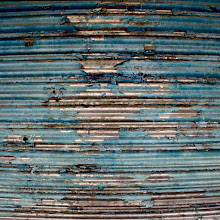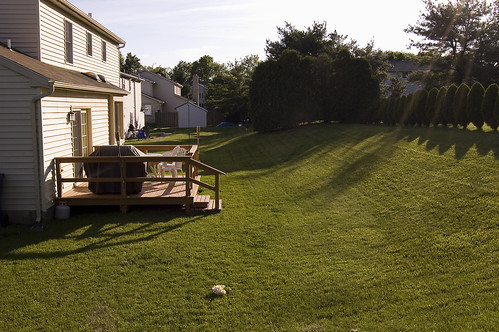
Target Practice (Look Hard for it!), Wedgewood Drive, West Allentown.
Despite being all over the place about making work the last few months, I've been thinking about three key motivating factors for making a sprawling, semi-coherent body of work about what it means to live, work and die in a landscape that has no here and therefore, has no there.
Or, in other words, what it means to live in the generic, consumer-driven, suburban, car-centric United States.
One: I recently finished James Howard Kunstler's Geography of Nowhere.
Two: I'm moving home, to Allentown, Lehigh Valley, Pennsylvania.
Three: I drive everyday, for one hour (if traffic is good) on a major interstate, I-93.
I am tentatively calling it "This American Landscape" in private but it probably can't be called that. So I'll go with "Nowhere Places and Nothing Towns".
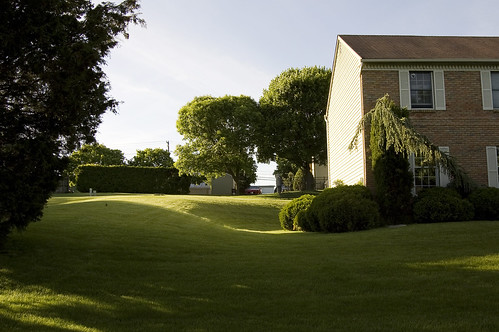
Green Green Grass that Grows Unnaturally All Around, Wedgewood Drive, West Allentown.
Although it was written 15 years ago, The Geography of Nowhere is, among many other things, a very precise, scathing commentary on the history, evolution and proliferation of Suburbia in the United States. It examines the landscape it produces, the physical, and psychological, and predicts the probable outcome of living in an unsustainable lifestyle that has been constructed around the car. Most importantly, in my case, it gave me a barrage of ideas to roll around in my head, to apply to my personal experience and to observe in real life.
I think of place as Lucy Lippard says in Lure of the Local: "Place is latitudinal and longitudinal within the map of a person’s life. It is temporal and spatial, personal and political. A layered location replete with human histories and memories, place has width as well as depth. It is about connections, what surrounds it, what formed it, what happened there, what will happen there." I can feel the subtleties of places when I go somewhere that has those layers. I can feel the distinction of Here or There. But my body, heart and brain also know when I am in no place, where the layers of human interaction and connections is virtually non-existent. I think that lack makes a place Nowhere.
So, I've been thinking a lot about Nowhere.
See, I grew up in a place that is very much There. It is a definable town, not only by it's borders but by the way it functions in it's layout. There are local, community supported businesses in it's downtown area, it's mostly walkable and it's got a very distinct, albeit quiet, history. It is very much a Here place that is distinct because it is Northumberland, Pennsylvania. It obviously has no interest in doing away with the notions that make it "Small Town America". It is also about 15 miles from the nearest interstate, which I will get to in a bit.
At 13, my parents and I moved to Allentown, Pa. More specifically, a housing development built by Field Stone Associates L.P. in Upper Macungie Township. Old Towne, which is neither Olde nor anything like a Town, is a planned community of wide, curving streets, small lush lots and houses of 23-2500 square feet with nearly identical floor plans. It is vast. It is also indistinguishable from most of the other housing developments that have sprung up in the Lehigh Valley and probably elsewhere in the U.S. Disconnected from places of commerce or culture, save a strip mall at the main entrance to the development, one can't really get anywhere outside of Olde Town without getting in a car and driving there.
Surprise.
It is no wonder I spent most of high school disoriented, stressed and saddened. Without four wheels and six cylinders, I was pretty much stuck. I couldn't take a mischievous walk around town with friends (I didn't have any in the neighborhood), get a piece of pizza, or spend time in communal areas which were, in summer, front porches and big yards. The front porch of the houses were merely a decoration, a gesture of Olde-ness instead of an extension of living space. The yards were a face to passer-bys to say "Look at how lovely my yard is." It had no history except the time frame of it's development. I was living in a place that was, for all intensive purposes, Nowhere and I was freaked the fuck out.
And then I forgot about how weird it was until I determined that my next course of action in life was to move home, get a job, pay off some debt and figure out what's next. Now that I know that I'll be living in that same nowhere place, I am distressed and conflicted. I became even more distressed and conflicted after finishing Kunstler's book two days before I was to go home for Memorial Day weekend. Driving the streets I learned to drive on, I had a feeling I've felt only a handful of times prior. It shows up in my stomach, a disorienting feeling of being somewhere geographically but being nowhere at the same exact time. It happens to me when I drive on big vast interstates that I've never been on before. It happens when I drive on new roads that cut across the old roads that I know like the back of my hand.
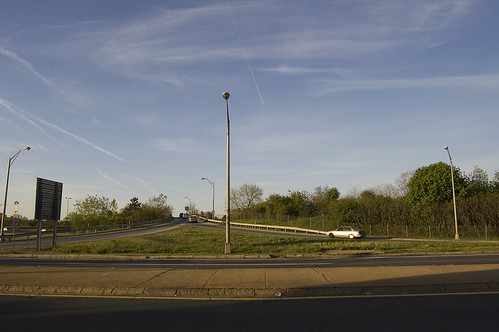
Exit/On Ramp 32, I-93, Medford, Ma
It also happened to me the first time that I drove to and from my (temporary) job in Methuen, Ma. It is 25 miles from Medford and is a straight shot on I-93 Northbound. I drive in the opposite direction of the traffic (thank the Good Lord) that's coming into Boston in rush hour. While I've sat in really bad traffic on the Masspike numerous times, I was awed by the sheer amount of cars barely creeping along in the southbound lanes. I was also awed by how far away the traffic into Boston stretched. I was dumbfounded by the mere thought of having to do that every single day.
I also got that creeping feeling of being Nowhere with a bunch of other people who were headed to Nowhere to work and to live. As Kunstler says "There is little sense of having arrived anywhere, because everyplace looks like noplace in particular." The Dwight D. Eisenhower National System of Interstate and Defense Highways, all 46,837 miles of it, is utterly Nowhere. You can get to a Here or a There but while traveling, you are Nowhere. You can travel through or around a place, like Toledo, Ohio or Hartford, CT but one doesn't really experience anything about that place at all; no local culture or cuisine, no people, nothing. One just passes right on by, onward to the next exit.
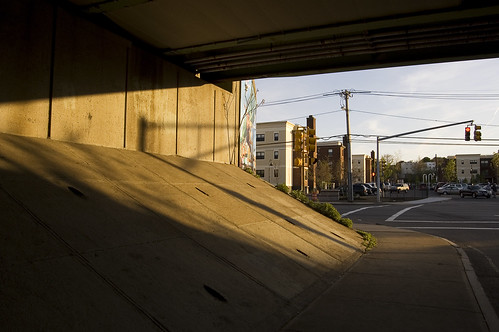
Mystic Avenue, Medford, Ma.
Since I moved to Medford, I-93 permeates my life. I have to drive on, around or under it when I want to go anywhere. I can watch the traffic from my bedroom window. I can hear the rush of cars in my apartment with the windows open. I've never thought of and been so aware of a road in my entire life like the way I've become aware of I-93 in the past few months. Growing up, the interstate was a far away, rarely thought of unless there was a vacation to be had. The concrete and asphalt of such a road rarely entered my vision.
And now, it's sort of all I can see. It is very much in my day-to-day routine. What I'm having trouble with is how something that is Nowhere has become such an integral part of my life. How does one live with and in Nowhere and be okay with that? Is there detachment? What does that do to one's sense of self and place? What about history? What about the present? What about the future?
I do what most Americans do when they live in Nowhere: I travel to a Here or a There in order to reconnect with place so that I can feel like things are normal, that this lifestyle of Nowhere is normal.
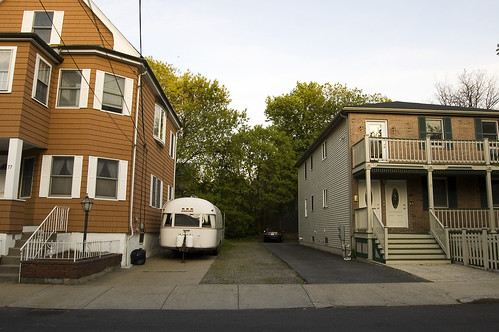
Aerodynamic! Moreland Street, Medford, Ma.
I, unfortunately, don't have such styling digs in which to escape.
That said, all of that above is a lot to think about. It is a lot to photograph. There is a lot that I am missing or haven't had the chance to think about. Scratching the surface, putting the ideas down, framed by pictures, is one way I can start to make sense of all of it. It is also the way that I will be able to live, temporarily, Nowhere and be able to cope with it.
I listen to the cars up on the interstate from my kitchen and wonder about the exits that those cars are barreling towards with such speed. I think about their passengers, their houses, their lives. Are they headed towards Nowhere? Or are they headed towards a There?

